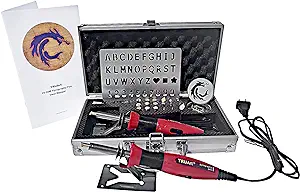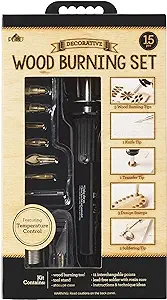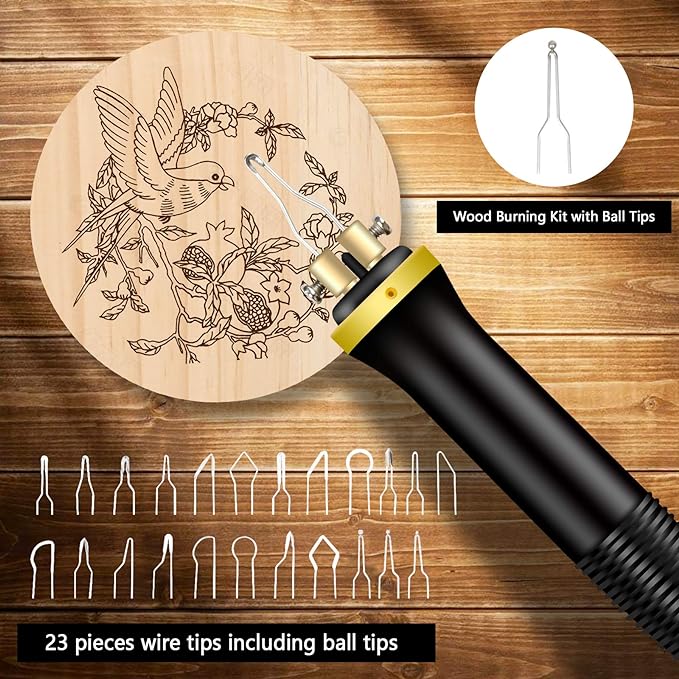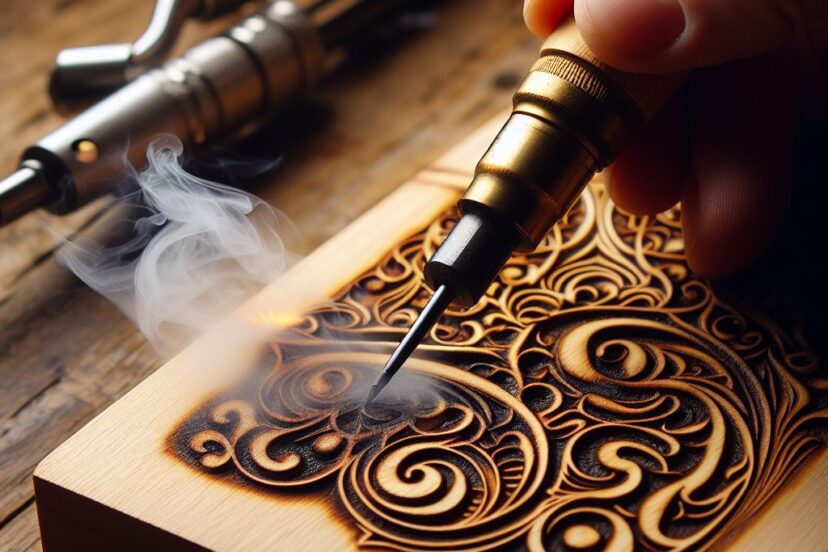Woodwork Burning Tool Guide: Best Pyrography Pens & Kits For Beginners
Key Takeaways
- Understanding the differences between solid tip and wire nib woodwork burning tool, as well as wattage and temperature control, is crucial for selecting the right kit.
- TruArt Stage 1 Pyrography Pen is the top choice woodwork burning tool for beginners, offering adjustable wattage and multiple tips.
- Walnut Hollow Creative Woodburner is a great runner-up, known for its reliability and ease of use.
- Plaid 30725 Decorative Wood-Burning Set provides excellent value for those starting out in pyrography.
- YSBMZP Wood-Burning Tool Kit is ideal for detailed work with its precision tips and dual pens.
Ignite Your Craft: Top Woodwork Burning Tool And Pyrography Pens
When you’re ready to delve into the world of pyrography, the art of wood burning, the first step is choosing the right woodwork burning tool. The perfect pyrography pen can turn a simple piece of wood into a masterpiece of art. It’s not just about the pen, though – a good kit provides the support and accessories you need to begin your crafting journey with confidence.
Why This Guide Matters
Pyrography is a rewarding hobby that combines artistic expression with the tactile joy of working with wood. With the right kit, beginners can quickly learn the basics and start creating their own unique designs. This guide is here to light the way, showcasing the best tools for those just starting out.
What Sets the Best Tools Apart
- Adjustable temperature controls for working on different types of wood.
- A variety of tip shapes for creating different textures and lines.
- Comfortable ergonomic designs to prevent hand fatigue during long crafting sessions.
- Durable construction to withstand the heat and pressure of pyrography work.
- Extra accessories such as stencils, stands, and carrying cases for added value.

The Artist’s Choice: TruArt Stage 1 Pyrography Pen Wood-Burning Tool Set
For those ready to embark on their pyrography journey, the TruArt Stage 1 Pyrography Pen Wood-Burning Tool Set stands out as a stellar starting point. This kit isn’t just about getting you started; it’s about setting you up for continued growth in the craft.
Features That Shine
- Variable temperature control with the option to switch between 15W and 30W, catering to a variety of projects.
- A comprehensive set of tips allows for versatility in your designs, from intricate details to bold, broad strokes.
- The inclusion of a steel stencil aids in creating precise letters and numbers, perfect for personalizing your work.
The TruArt Stage 1 set is designed with the beginner in mind, but it doesn’t skimp on the features that more advanced crafters appreciate. The ability to adjust the wattage means you can work on a range of materials, from softer woods that require less heat to harder varieties that need more power. Moreover, the variety of tips opens up a world of creative possibilities, allowing you to experiment with different effects and textures.
Pros and Cons
Every tool has its advantages and disadvantages, and the TruArt Stage 1 is no exception. Let’s weigh them up:
- Pros:
- Adjustable wattage for versatility.
- Wide range of tips for different artistic effects.
- Steel stencil included for precision work.
- Cons:
- May be slightly more expensive than other beginner kits.
- Some users may prefer a pen with an LCD display for precise temperature readings.
While it’s a bit pricier than some other options, the TruArt Stage 1 kit offers enough versatility to justify the investment. And while it lacks an LCD temperature display, the dual wattage option still provides ample control for most projects.

Best Value for Beginners: Plaid 30725 Decorative Wood-Burning Set
For those who are budget-conscious but eager to start pyrography, the Plaid 30725 Decorative Wood-Burning Set is a fantastic option. It’s priced to be accessible for beginners, yet it includes enough variety in tips and accessories to get a solid start in the craft.
What’s in the Box?
The Plaid 30725 set comes with all the essentials to begin your wood-burning journey:
- A wood-burning pen with a comfortable handle.
- A stand to rest the pen on while not in use or when it’s hot.
- An assortment of tips for different burning techniques.
This kit is particularly appealing for its simplicity and ease of use, making it less intimidating for newcomers to the craft. With enough tips to try out various techniques, it’s a practical choice for those looking to explore pyrography without a significant upfront investment.
Navigating Its Limitations
However, the Plaid 30725 isn’t without its limitations. It has a single temperature setting, which means you have less control over the burn intensity compared to variable temperature pens. Also, the pen may take a bit longer to heat up than more expensive models.

Fine Detailing: YSBMZP Wood-Burning Tool Kit
When it’s time to add intricate details to your wood-burning projects, the YSBMZP Wood-Burning Tool Kit steps up to the plate. This kit is a dream for crafters who are ready to move beyond the basics and add fine details to their work.
The YSBMZP kit is a step up in terms of precision and control, featuring a digital temperature control that allows for fine-tuning. The dual-pen system means you can have two different tips ready to go, reducing wait times when switching between techniques.
Precision Tools for Artful Projects
The YSBMZP kit includes:
- Two pens with insulated, comfortable grips for extended use.
- A digital control station for precise temperature adjustments.
- A variety of wire nibs for detailed work.
This setup is perfect for those who have a passion for detail and aspire to create intricate designs. The variety of wire nibs allows for precise linework, shading, and texturing, which are essential for advanced pyrography projects.
Balancing Quality with Cost
While the YSBMZP Wood-Burning Tool Kit offers professional features, it’s still within a price range that is accessible for hobbyists. It strikes a balance between quality and cost, providing features typically found in higher-end kits without the hefty price tag.
Selecting Your Perfect Pyrography Pen
Choosing the right pyrography pen is crucial for your crafting success. Whether you’re creating art for pleasure or considering selling your work, the pen you choose will significantly affect the quality and detail of your finished pieces.
Solid Tip vs. Wire Nib
There are two main types of pyrography pens – solid tip and wire nib – and each has its own advantages:
- Solid Tip: Typically easier for beginners to handle, they heat up quickly and are good for bold, straightforward designs.
- Wire Nib: Offers more flexibility and precision, better for detailed work, and allows for more intricate designs.
Beginners might start with a solid tip for its ease of use, but as you grow in skill, a wire nib can take your work to the next level with its ability to create finer details.
Considering Wattage and Heat Control
The wattage of your pyrography pen determines how hot it can get, which in turn affects how it interacts with different types of wood. Pens with adjustable temperature controls give you more versatility, allowing you to work on a wider range of materials and achieve various effects.
Comfort and Ergonomics
Comfort is key when it comes to pyrography. Look for pens with ergonomic designs that fit well in your hand to prevent fatigue during long crafting sessions. A pen with a comfortable grip will allow you to work longer and with greater precision.
Enhancing Your Craft with Accessories
Once you’ve chosen your pyrography pen, it’s time to consider the accessories that will enhance your crafting experience. A good kit often comes with a variety of extras, but there’s always room to personalize and expand your toolkit.
Accessories can range from practical items like extra tips and safety stands to creative aids like pattern books and color fillers. These additions not only make the process more enjoyable but also open up new avenues for creativity and expression.
Must-Have Add-Ons for Your Woodwork Burning Tool Kit
Here are some must-have add-ons that I recommend for every pyrography enthusiast:
- A solid metal stand to safely rest your hot pen.
- Additional tips for different textures and effects.
- Stencils for consistent and intricate designs.
- Carbon paper for transferring patterns onto wood.
- Sanding paper to prep your wood surface for a smoother burn.
These accessories will not only help you work more efficiently but will also expand the range of projects you can tackle. For example, stencils can be a game-changer when you’re looking to create detailed and repetitive designs.
From Woodworking to Soldering: The Versatility of Pyrography Pens
Pyrography pens are incredibly versatile tools. While they are primarily used for wood burning, many are also capable of functioning as soldering irons or for burning designs into other materials like leather or cork.
This versatility means that investing in a quality pyrography pen can open up a wide range of crafting possibilities beyond just wood burning. As your skills develop, you might find yourself exploring these other crafts with the same tool you started with.
Frequently Asked Questions (FAQ) On Woodwork Burning Tool
As you embark on your pyrography journey, questions are bound to arise. Let’s address some of the most common queries:
Understanding the ins and outs of pyrography pens and kits is crucial as you start this crafting journey. With the right knowledge, you can select the best tools for your needs and begin creating beautiful wood-burned art.
1. Can I Use These Pens on Different Materials Besides Wood?
Absolutely! While wood is the most common material for pyrography, many pens are also suitable for burning designs onto leather, cork, and even paper. Just remember to adjust the temperature accordingly and always test on a scrap piece first.
2. Are Higher Wattage Pens Always Better?
Not necessarily. Higher wattage pens can reach higher temperatures, which is great for working on harder woods, but for beginners and those working on softer woods, a lower wattage with adjustable temperature might be more suitable. It’s all about finding the right balance for the materials you plan to work with.
- Lower wattage is often sufficient for softwoods and beginners.
- Higher wattage pens are better for hardwoods and advanced techniques.
- Adjustable temperature controls offer the most versatility.
It’s important to start with a pen that matches your skill level and the projects you wish to undertake. As you gain experience, you can upgrade to a higher wattage pen if needed.
3. How Do I Know Which Tip to Use for My Project?
Choosing the right tip depends on the design you’re aiming for. For detailed guidance on different woodworking joints and techniques, consider exploring more resources.
- Use a fine tip for detailed work and intricate lines.
- Opt for a broader tip for shading and filling larger areas.
- Specialized tips, like calligraphy or stamping ones, are great for specific effects.
Experiment with different tips on scrap wood to see the effects they create before starting on your actual project.
4. Can Beginners Achieve Professional Results with These Kits?
With practice and patience, absolutely. Starting with a beginner-friendly kit allows you to learn the basics and gradually improve your skills. As you become more comfortable with the tool and techniques, your results will naturally become more polished and professional.
5. Is it Safe to Switch Tips While the Pen is Hot?
It’s generally not recommended to switch tips while the pen is hot due to the risk of burns. Most pens come with a stand or holder where you can safely rest the pen while it cools down. Always use pliers or a similar tool when changing tips to avoid direct contact with the hot metal.
Remember, safety first! Always follow the manufacturer’s instructions and take precautions to work safely.




